The KlimTAX Guide provides recommendations for conducting a robust climate risk analysis (KRA) in accordance with the EU Taxonomy Regulation 2020. Companies aiming for EU Taxonomy compliance must make a significant contribution to one of the six defined environmental objectives, avoid significantly harming any of them, and adhere to minimum social standards.
Focus on Climate Risk Analysis (KRA)
Under Environmental Objective 2: "Adaptation to Climate Change", conducting a Climate Risk Analysis (KRA) is a central requirement. Additionally, the "Do-no-significant-harm" (DNSH) principle applies across all environmental objectives, which also necessitates a KRA. As a result, all companies are required to perform a KRA as part of their EU Taxonomy compliance assessment.
The requirements for KRA are outlined in delegated acts (Regulation (EU) 2021/2139 & Regulation (EU) 2023/2486). However, there are still ambiguities and open questions regarding their implementation. This guide aims to address these issues as much as possible. Conducting a KRA requires companies to assess the impacts of current and future climatic conditions on their economic activities, leading to a better understanding of potential climate risks and adaptation measures to mitigate them.
Key Components of Climate Risk
Climate risk is determined by three factors:
- Hazard: The specific climate-related threat.
- Exposure: The degree to which the economic activity is exposed to the hazard.
- Vulnerability: The susceptibility of the activity to the hazard.
Identifying relevant hazards and vulnerabilities poses a significant challenge for companies. To address this, the guide outlines five steps for conducting a KRA, accompanied by guiding questions for both the conducting and commissioning organizations.
Data and Indicators
For economic activities with a lifespan of more than 10 years, climate model data must be used. The guide lists potential datasets for Austria and other European countries. It also describes which hazards, as outlined in Annex I, Appendix A, can be scientifically derived from existing models. Additionally, relevant indicators for determining hazards are provided, which may vary depending on the risk being analyzed.
Target Audience
The guide offers recommendations for conducting KRAs within the EU Taxonomy framework and is intended for companies and institutions that:
- Conduct or commission climate risk analyses,
- Offer climate risk analysis services, or
- Review climate risk analyses.
It is important to note that the guide focuses specifically on KRAs within the EU Taxonomy framework (not the Corporate Sustainability Reporting Directive) and provides recommendations accordingly. However, it does not replace expert knowledge.
Project Background
The KlimTAX project emerged from the Working Group on Climate Risk in ESG Reporting and was funded by the Climate and Energy Fund.

